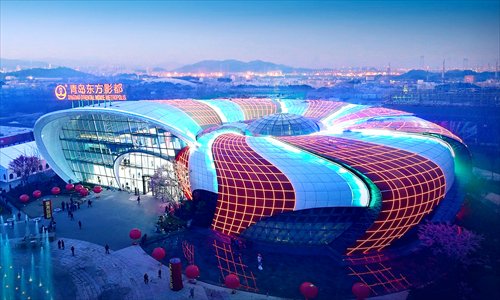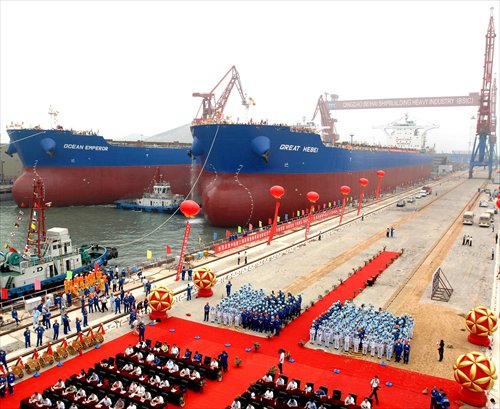HOME >> BUSINESS
Qingdao sets sail
Source:Global Times Published: 2014-11-10 19:23:01
A new marine development zone aims to build China’s maritime power

Qingdao's skyline lit up at night Photo: Wang Hongyun
Along the 36th parallel north, there are many beautiful and sunny bay cities, like San Francisco and Tokyo. Qingdao, with its West Coast New Area (WCNA), is now seeking to join these coastal cities with its own innovative development.The WCNA was set up in June in Qingdao, East China's Shandong Province, as the ninth national "new area" to promote the city's economic development and to lead innovation on the Shandong Peninsula.
The WCNA is a national new area and a comprehensive reform pilot zone. Its outstanding geographic advantages, solid industrial foundation and rich reserve of talent and top technologies, provide an excellent basis for the coastal area to grow to become a world-leader in marine development.
After the Blue Economic Zone, a regional ocean economic zone that seeks to establish the city as a leading international shipping center, was approved in 2011, the State Council is once again looking to Qingdao to implement China's national maritime strategy and to forge a solid foundation for the building up of China's maritime power.

A nautilus shaped exhibition center in the Qingdao Oriental Movie Metropolis, a major studio that combines film and television production facilities and a theme park. Photo: Courtesy of the Publicity Department of Qingdao West Coast New Area
Qingdao's advantagesLocated on the west bank of Jiaozhou Bay and covering the Huangdao district of Qingdao, the WCNA has a land area of 2,096 square kilometers and sea area of 5,000 square kilometers. With a population of 1.71 million, the WCNA will be developed into a marine economic zone, utilizing the advantages of its natural geography to grow its marine science and technology industries.
Situated on the Shandong Peninsula, the WCNA will become an economic gateway to Beijing and Tianjin and the prosperous Yangtze River Delta. Jiaozhou Bay is the main estuary of the Yellow River and lies on the intersection of the Shengyang-Haikou highway and the Qingdao-Yinchuan highway.
Qingdao is also just off the coast of the Korean Peninsula and is close to Japan. This location, well connected to other markets by land and sea routes, offers Qingdao and the WCNA great geographical advantages and sets the stage for it to become an important hub of Pacific trade.
Qingdao is well-known for its marine science and technology industries. The Ocean University of China, the Institute of Oceanology of the Chinese Academy of Science and other oceanic research centers provide the city with an international standard of scientific research.
Since the implementation of the10th Five-Year Plan, 55 percent of National High-tech R&D Program (the 863 Program) projects and 91 percent of National Basic Research Program (the 973 Program) projects have been worked on by experts in Qingdao.
For centuries, Qingdao has been significant shipping center for both China and Asia as a whole. The WCNA contains two deep water harbors, Qianwan and Dongjiakou, which have a combined throughput capacity of more than 700 million tons a year.
In 2013, the volume of incoming and outgoing shipments reached 15.52 million containers, making Qingdao the seventh busiest harbor in the world and the fifth ranking Chinese port in terms of foreign trade. Trading with over 450 other ports in 130 countries and regions, Qingdao's new area already has a solid economic foundation on which to grow an ever greater trade in strategic resources.
The WCNA, together with the already established development areas of the Qingdao Economic and Technological Development Zone, the Qindao Qianwan Free-Trade Port, the Qingdao West Coast Export Processing Zone, the Qingdao New-tech Industrial Development Experimental Zone and the Qingdao Sino-German Ecopark, has created a build-up effect that has attracted a wide range of industries to move to the city, including the shipping industry, the petrochemical industry, electronics manufacturers and the mechanical industry. In 2013, the total value of the area's output reached 226.6 billion yuan ($37 billion) and its GDP per capita was over $20,000, three times the country's average.

A ceremony is held to mark the completion of China's largest shipyard in Haixiwan Bay, Qingdao. Photo: Wang Weiqing
Strategic orientationThe establishment of the WCNA is a significant step in achieving China's long-term maritime strategy. From the Blue Economic Zone to new coastal construction projects, Qingdao is making great efforts to fulfill its commitment to responsible oceanic growth.
Qingdao's rich history of scientific research focusing on the ocean means that it has the necessary capabilities to build a marine science and technology pilot zone that can independently innovate. Its abundant oceanic resources, elite scholars and strong policy support on the national level ensure that the WCNA will be able to become a new heartland of marine science and technology.
With the help of technology pioneered in China's growing space industry, the WCNA is designed to become a platform for deep sea development and to facilitate an interaction between the sea and land.
Sea and land are bound together, and it is important to make full use of inland resources while developing the marine economy. One task of the new area is to effectively integrate the land and sea based resources.
Bringing together construction on the land, shipping, energy supply networks and information communication, this new method of developing a coastal economy will focus on ecological protection and the cohesive planning of the new area.
Innovative layout
The structure of the WCNA is designed to combine economic functions with ecological protection, and has laid out a unique pattern that suits the city's location at the intersection of land and sea.
The first innovative step in the building the WCNA was to reform the administrative examination and approval system when it came to the departments of industry and commerce, urban construction, land and taxation. The process of official examination of investment programs has been simplified and the waiting period has been shortened from 15 days to three days.
The WCNA will also contain a new central business district to help create a new center within Qingdao for administration, finance and business as well as cultural and educational activities.
With a focus on high-level marine businesses, scientific innovation, cultural industries and tourism, the center will be fully equipped to hold international events that promote the city's cultural industries
The WCNA will seek to, along with its two existing ports, integrate air transportation into the city's development to improve the overall service capabilities of the city's international and domestic trade.
Within the WCNA there are five specific areas that will help to foster the prosperity of the new area.
The Qingdao Qianwan Free Trade Port will help enhance the functioning of the port and grow trade, in addition to its focus on the overall development of the city's logistics.
The Qingdao Economic and Technological Development Zone will seek to improve the services offered by the Sino-German Ecopark, the Sino-Japanese Innovation Park and the city's international tourist resorts by implementing eco-friendly technologies and training systems.
The WCNA Center's role is to promote new industries, including the marine biology sector, new material sciences and digital electronics.
The Dongjiakou Economic Zone plans to push forward the integrated development of the ports, industries and the city, by taking the full advantage of oceanic resources, shipping services and the city's existing industrial foundation.
The Modern Agricultural Experimental Zone will work on ecological agriculture and tourism.
Future development
It is planned that the total value of the WCNA's output will reach 320 billion yuan by 2016, with an annual growth rate of 12 percent. The total value of the marine output of the WCNA is planned to be 80 billion yuan, increasing year on year by 17 percent. In order to achieve this goal, more work is needed.
Independent innovation research into marine sciences and technology is the priority of the WCNA. Its solid marine technology foundation and rich resources of top talent guarantee that it will efficiently engage in deep water exploitation.
With the help of the "blue silicon valley," which can provide the latest technological achievements in the area of marine science, the new area will develop programs for the sustainable use of marine biological resources and the proactive study of the ocean and global climate change.
The construction of an international air hub aims to create a major transportation center for Southeast Asian trade to better develop the WCNA. Optimizing the city's rail, sea and freeway infrastructure, in addition to promoting cooperation with nearby ports, will help establish the WCNA as a major economic area.
Continuing China's opening up is the most important part of Qingdao's further development. To make the WCNA's shipping and air transportation businesses internationally competitive, the government has established free trade zones and implemented policies favorable to trade. Moreover, increasing its connections to the prosperous Yangtze delta and the Beijing-Tianjin- Hebei region will improve regional collaboration
Maintaining growth of the maritime economy, building a new and beautiful city and protecting the environment are at the top of the WCNA's agenda. Proper management of the coast and nearby islands is the basis for further exploration in the area.
Posted in: Press Release